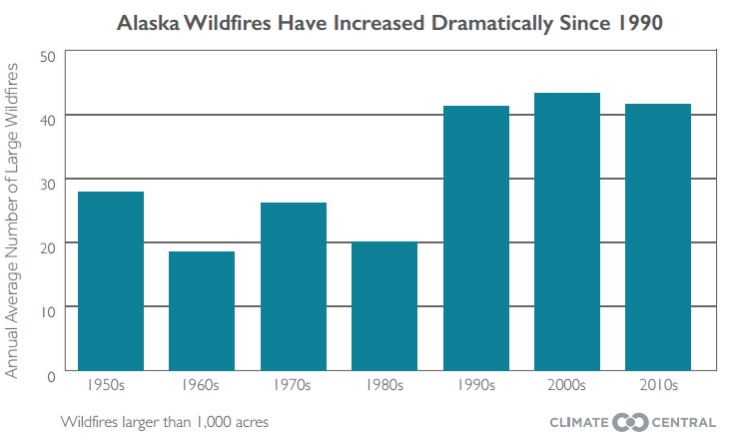Alaska Wildfires Getting Stronger And Lasting Longer: Report

As of Wednesday, a total of 276 wildfires are believed to be burning in the northern U.S. state of Alaska, according to an estimate by the Alaska Interagency Coordination Center. Alarmingly, the long-term record, detailed in a new report by Climate Central, shows that not only are the fires getting larger the wildfire season itself is expanding.
“Alaska’s wildfire season is about 40 percent longer now than it was in the 1950s,” Climate Central found, during its analysis of data from the last 65 years. “The first wildfires start earlier in the year, and the last wildfires are burning longer into the fall. Overall, the wildfire season has increased more than 35 days and is now more than three months long, running from May through early August.”
The number of large wildfires -- covering an area of over 1,000 acres -- suddenly increased in the 1990s, according to the report. While the number of such fires stood at 20 in the 1980s, in the following decade it increased to more than 40 and has since remained over that level.
These fires are also consuming larger areas than ever before. In 2004 and 2005, for instance, wildfires burned an area bigger than in the 15 years between 1950 and 1964, the report found.

“According to the National Climate Assessment, the amount of area burned in Alaskan wildfires is projected to double by 2050 and triple by 2100 under continued emissions and further warming,” the report warned.
Moreover, in Alaska's north, closer to the Arctic Circle, the number of large tundra wildfires soared nearly tenfold in the 2000s compared to the 1950s and 1960s. Since 2000, there have been 33 large wildfires in the Arctic, according to the report.
In the global context, these Arctic fires pose a greater threat than the fires in the interior and south-central regions of the state. The Arctic region has vast reserves of carbon stored in the permafrost. When wildfires break out in this area, they release carbon into the atmosphere, helping drive global temperatures even higher -- resulting in, as the report points out, a self-sustaining cycle wherein higher temperatures increase the frequency of wildfires.
The Anaktuvuk River fire on Alaska’s North Slope in 2011, for example, released approximately as much carbon into the atmosphere as the tundra had stored in the previous 50 years, according to a study published in the journal Nature.
“In the past 60 years, Alaska has warmed more than twice as fast as the rest of the country, with average temperatures up by nearly 3 degrees Fahrenheit. By 2050, temperatures are projected to climb an additional 2 to 4 degrees, with the Arctic region seeing the most dramatic increases. These rising temperatures are expected to increase wildfire risks in Alaska, just as they have in the rest of the western U.S.,” the report said.
The trends outlined in the latest report are similar to the ones observed in the lower 48 states -- detailed in a 2012 report by Climate Central. According to that report, wildfires were, on average, burning twice as much land area each year as they did 40 years ago and the burn season was also two and a half months longer than in the 1970s.
© Copyright IBTimes 2025. All rights reserved.






















